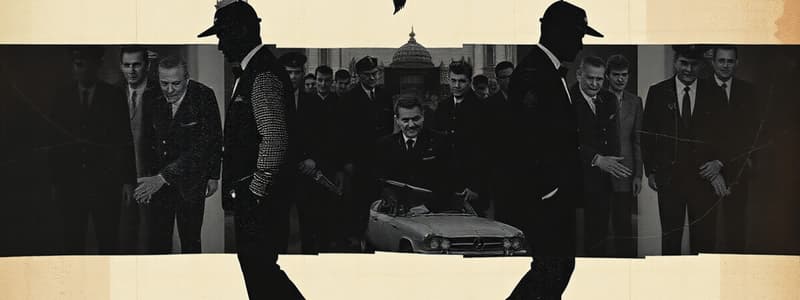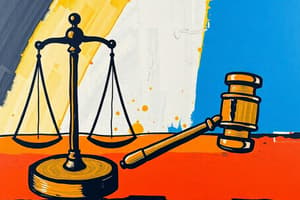Podcast
Questions and Answers
Which factor is LEAST likely to contribute to globalization?
Which factor is LEAST likely to contribute to globalization?
- Decreased communication technologies. (correct)
- Enhanced interconnection of countries.
- Increased international media coverage.
- The rise of social media platforms.
What is the critical element that transforms an event into a 'criminal event'?
What is the critical element that transforms an event into a 'criminal event'?
- The level of physical harm caused.
- The severity of the punishment prescribed by law.
- The interpretation and acknowledgement of the event as a crime. (correct)
- The inherent nature of the action itself.
Why might crime rates be favored over simple counts of crime incidents (incidence)?
Why might crime rates be favored over simple counts of crime incidents (incidence)?
- Incidence always reflects the true level of crime.
- Rates can help mitigate public panic by providing context. (correct)
- Incidence is harder to calculate than rates.
- Rates are only useful for small populations.
Which statement best describes the relationship between the True Crime Rate (TRC), Crimes Known to Police (CKP), and the 'dark figure' of crime?
Which statement best describes the relationship between the True Crime Rate (TRC), Crimes Known to Police (CKP), and the 'dark figure' of crime?
How does the 'reportability' of a crime MOST directly affect crime statistics?
How does the 'reportability' of a crime MOST directly affect crime statistics?
If a particular type of crime is considered 'over-represented' in media coverage, what does this likely indicate?
If a particular type of crime is considered 'over-represented' in media coverage, what does this likely indicate?
How do official and unofficial measures of crime typically differ in scope?
How do official and unofficial measures of crime typically differ in scope?
Why are crimes 'cleared by arrest' smaller than crimes known to the police (CKP)?
Why are crimes 'cleared by arrest' smaller than crimes known to the police (CKP)?
Which of the following factors contributes most significantly to the mass media's distorted portrayal of crime, criminals, and victims?
Which of the following factors contributes most significantly to the mass media's distorted portrayal of crime, criminals, and victims?
The concept of 'Black on Black crime' is often critiqued for what reason?
The concept of 'Black on Black crime' is often critiqued for what reason?
How does mass media's racialization of drug users and dealers typically compare with actual drug usage and sentencing patterns?
How does mass media's racialization of drug users and dealers typically compare with actual drug usage and sentencing patterns?
What are the two primary methods by which social order is typically enforced?
What are the two primary methods by which social order is typically enforced?
How is ideology linked to social structure and social dynamics?
How is ideology linked to social structure and social dynamics?
What does the term 'ideological effects' of crime images refer to?
What does the term 'ideological effects' of crime images refer to?
How is hegemony primarily maintained, and how does it relate to force?
How is hegemony primarily maintained, and how does it relate to force?
What is the key difference between hegemonic and counter-hegemonic forces?
What is the key difference between hegemonic and counter-hegemonic forces?
How do media depictions, official statistics, and crime myths contribute to the maintenance of hegemony?
How do media depictions, official statistics, and crime myths contribute to the maintenance of hegemony?
Which of the following best describes the seeming paradox of implicit bias?
Which of the following best describes the seeming paradox of implicit bias?
In what way does implicit bias function as a cultural phenomenon?
In what way does implicit bias function as a cultural phenomenon?
How does implicit bias relate to the maintenance of social order?
How does implicit bias relate to the maintenance of social order?
Which scenario exemplifies a situation where implicit bias is MOST likely to influence decision-making?
Which scenario exemplifies a situation where implicit bias is MOST likely to influence decision-making?
Considering the impact of implicit bias on the criminal justice system (CJS), which of the following CJS processes is LEAST likely to be affected?
Considering the impact of implicit bias on the criminal justice system (CJS), which of the following CJS processes is LEAST likely to be affected?
What is the KEY difference between fast thinking and slow thinking, and how does it relate to implicit bias?
What is the KEY difference between fast thinking and slow thinking, and how does it relate to implicit bias?
How does the 'white gaze' function ideologically, historically, and hegemonically?
How does the 'white gaze' function ideologically, historically, and hegemonically?
If an offender commits both robbery and aggravated assault during a single incident, how would the UCR's hierarchy rule affect the reporting of this event?
If an offender commits both robbery and aggravated assault during a single incident, how would the UCR's hierarchy rule affect the reporting of this event?
In what fundamental way does the NCVS differ from the UCR and NIBRS in its approach to collecting crime data?
In what fundamental way does the NCVS differ from the UCR and NIBRS in its approach to collecting crime data?
Which of the following is a key advantage of NIBRS over the UCR?
Which of the following is a key advantage of NIBRS over the UCR?
What is a primary reason for the incomplete transition from the UCR to NIBRS across all law enforcement agencies in the U.S.?
What is a primary reason for the incomplete transition from the UCR to NIBRS across all law enforcement agencies in the U.S.?
What potential impact could the full-scale adoption of NIBRS have on the perception of crime rates, especially when compared to data from the UCR?
What potential impact could the full-scale adoption of NIBRS have on the perception of crime rates, especially when compared to data from the UCR?
The UCR's Part 1 offenses are based on crimes known to the police. Which of the following is an example of a Part 1 offense?
The UCR's Part 1 offenses are based on crimes known to the police. Which of the following is an example of a Part 1 offense?
If a researcher is interested in understanding the prevalence of domestic violence incidents, which data source would likely provide the most comprehensive information?
If a researcher is interested in understanding the prevalence of domestic violence incidents, which data source would likely provide the most comprehensive information?
What patterns of crime are more accurately revealed by the NCVS compared to the UCR and NIBRS?
What patterns of crime are more accurately revealed by the NCVS compared to the UCR and NIBRS?
How did the modifications to the NCVS in 1992 primarily affect crime statistics related to offenses against women and individuals known to the victim?
How did the modifications to the NCVS in 1992 primarily affect crime statistics related to offenses against women and individuals known to the victim?
What is the most accurate interpretation of the phrase 'theory laden' in the context of crime facts and statistics?
What is the most accurate interpretation of the phrase 'theory laden' in the context of crime facts and statistics?
A researcher develops a new method for measuring recidivism rates. The method yields consistent results across different samples and time periods, but the results don't align with established measures of recidivism. What can be said about this new method?
A researcher develops a new method for measuring recidivism rates. The method yields consistent results across different samples and time periods, but the results don't align with established measures of recidivism. What can be said about this new method?
Why is triangulation considered a valuable approach in crime data collection and analysis?
Why is triangulation considered a valuable approach in crime data collection and analysis?
In what way does media bias potentially distort the accuracy of the UCR data regarding crime rates?
In what way does media bias potentially distort the accuracy of the UCR data regarding crime rates?
How does the voluntary nature of participation in the UCR program potentially affect the accuracy of the collected crime data?
How does the voluntary nature of participation in the UCR program potentially affect the accuracy of the collected crime data?
How does the 'hierarchy rule' within the UCR potentially distort crime statistics?
How does the 'hierarchy rule' within the UCR potentially distort crime statistics?
What primary factor contributes to certain crimes becoming 'invisible' in official crime statistics?
What primary factor contributes to certain crimes becoming 'invisible' in official crime statistics?
Flashcards
Social Order
Social Order
The system of norms and values maintaining stability and preventing chaos.
Hegemony
Hegemony
A dominant social order maintained through culture and consent, not just force.
Ideology
Ideology
A group-based, partial perspective constructed by social structures.
Counter-Hegemonic
Counter-Hegemonic
Signup and view all the flashcards
Racialization of Crime
Racialization of Crime
Signup and view all the flashcards
Media Distortion
Media Distortion
Signup and view all the flashcards
Consent in Hegemony
Consent in Hegemony
Signup and view all the flashcards
Black on Black Crime
Black on Black Crime
Signup and view all the flashcards
Actus Reus
Actus Reus
Signup and view all the flashcards
Mens Rea
Mens Rea
Signup and view all the flashcards
Strict Liability
Strict Liability
Signup and view all the flashcards
Felony
Felony
Signup and view all the flashcards
Misdemeanor
Misdemeanor
Signup and view all the flashcards
Criminal Law vs Civil Law
Criminal Law vs Civil Law
Signup and view all the flashcards
Stare Decisis
Stare Decisis
Signup and view all the flashcards
International Criminal Court (ICC)
International Criminal Court (ICC)
Signup and view all the flashcards
Implicit Bias
Implicit Bias
Signup and view all the flashcards
Fast Thinking
Fast Thinking
Signup and view all the flashcards
Slow Thinking
Slow Thinking
Signup and view all the flashcards
Cultural Phenomenon of Implicit Bias
Cultural Phenomenon of Implicit Bias
Signup and view all the flashcards
Overt Bias vs Implicit Bias
Overt Bias vs Implicit Bias
Signup and view all the flashcards
Factors Increasing Fast Thinking
Factors Increasing Fast Thinking
Signup and view all the flashcards
White Gaze
White Gaze
Signup and view all the flashcards
Implications in Criminal Justice System
Implications in Criminal Justice System
Signup and view all the flashcards
Police-based Data
Police-based Data
Signup and view all the flashcards
Victim-based Data
Victim-based Data
Signup and view all the flashcards
UCR (Uniform Crime Reporting)
UCR (Uniform Crime Reporting)
Signup and view all the flashcards
Part 1 Crimes
Part 1 Crimes
Signup and view all the flashcards
Hierarchy Rule
Hierarchy Rule
Signup and view all the flashcards
NIBRS (National Incident-Based Reporting System)
NIBRS (National Incident-Based Reporting System)
Signup and view all the flashcards
NCVS (National Crime Victimization Survey)
NCVS (National Crime Victimization Survey)
Signup and view all the flashcards
UCR vs. NIBRS
UCR vs. NIBRS
Signup and view all the flashcards
Globalization
Globalization
Signup and view all the flashcards
Proto-criminal event
Proto-criminal event
Signup and view all the flashcards
Incident vs Incidence
Incident vs Incidence
Signup and view all the flashcards
True Crime Rate (TRC)
True Crime Rate (TRC)
Signup and view all the flashcards
Reportability
Reportability
Signup and view all the flashcards
Official crime measures
Official crime measures
Signup and view all the flashcards
Unofficial crime measures
Unofficial crime measures
Signup and view all the flashcards
Over-representation vs Under-representation
Over-representation vs Under-representation
Signup and view all the flashcards
NCVS Modification 1992
NCVS Modification 1992
Signup and view all the flashcards
Valid vs Reliable Data
Valid vs Reliable Data
Signup and view all the flashcards
Triangulation
Triangulation
Signup and view all the flashcards
UCR Bias Sources
UCR Bias Sources
Signup and view all the flashcards
Structural vs Process Critiques
Structural vs Process Critiques
Signup and view all the flashcards
Invisible Crime
Invisible Crime
Signup and view all the flashcards
True Crime Rate
True Crime Rate
Signup and view all the flashcards
Theories Shaping Crime Stats
Theories Shaping Crime Stats
Signup and view all the flashcards
Study Notes
Criminology Study Guide
- Criminology is the study of crime, law breaking, and the response to crime.
- Three subfields of criminology include: law breaking, responses to crime, criminological theory.
- Social constructionism is the process of ascribing meaning to crime - varying across time, cultures, and political situations.
- Crime is socially relative; its meaning is made through social constructions, and variation happens across societies.
- Social relativity dimensions include historical variation, cross-cultural variation, and intra-societal/political variation.
- Social construction impacts societal responses, crime waves/moral panics, and social patterns (e.g. fear of crime, victimization, gender, race).
- The criminalization process involves first defining something as criminal, then observing the behavior, and responding to detected crime.
- Competing views exist about the criminalization process, ranging from it being rational and humane to defending certain interests at the expense of others.
- Crime is a sociological concept, with origins in political, economic, social, and cultural forces.
- Knowledge of crime can come from everyday life, but knowledge is not always accurate.
- Media plays a role in shaping perceptions of crime as a social problem.
- Official crime measures are part of the crime process.
- The unholy trinity includes fear of crime, actual crime, and crime imagery: these factors are interconnected.
- Sociologically, the unholy trinity's relationship to fear of crime is socially patterned by race, class, gender, and news consumption.
Additional Topics
- Newsmaking criminology focuses on the interpretation, understanding, and shaping of crime and justice in the media..
- Fear of crime is a socially patterned experience, not random, with specific examples relating to crime types (street vs. suite/white collar), and perpetrators (strangers vs. those known).
- Crime rates are influenced by crime type (e.g. street crime versus white-collar crime), and by the media.
- Crime rate perception differs depending on knowledge sources (e.g., media) and the actual reality of crime incidences.
- Factors such as news consumption and demographics influence fear of crime perceptions.
Defining Crime
- Two major approaches to defining crime exist: legal and sociological.
- Legal definition is explicit, straightforward, and ignores politics.
- Sociological definition is broader and considers criteria beyond legal ones, emphasizing politics.
- Legal Paradigms (e.g. Actus Reus, Mens Rea) and sociological paradigms shape how we understand crime.
- Definitions of crime change the paradigms and are used for action taking.
Crime Measurement
- Official vs. unofficial crime measures exist (with contrasts and comparisons) and both help determine the crime rate based on what the police or the victim report
- The Uniform Crime Reporting (UCR) Program is a system for measuring crime in the United States, compiled by the FBI; it shows crime patterns.
- The National Crime Variation Survey (NCVS) compiles crimes that people report to provide information about different crime types, demographics, and patterns..
Studying That Suits You
Use AI to generate personalized quizzes and flashcards to suit your learning preferences.




